Since the foundation of the "Deutsches Reich" by Otto von Bismarck on January 18, 1871, Berlin is the capital of what we now call Germany. During the National Socialist regime under Adolf Hitler the center of power was located particularly in the vicinity of the Wilhelmstrasse. All that remains of the here located Old Reich Chancellery (1878), the New Reich Chancellery (1938), the Vorbunker and the Führerbunker after the Russian demolition works of the last century are underground remnants. Yet there is still plenty to see in Berlin for the visitor interested in World War Two.
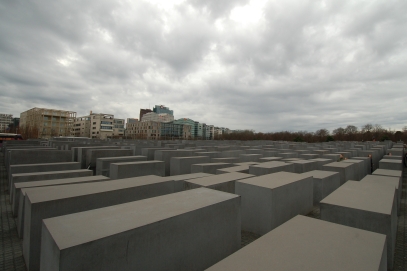
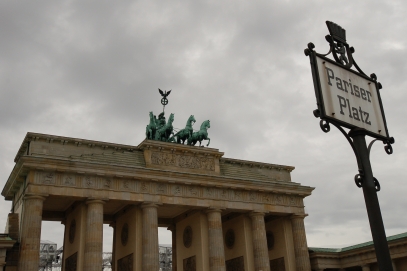
The Field of Stelae of the Holocaust-Memorial (1) and the Brandenburger Tor (2) located at walking distance.
Holocaust-Memorial
The Holocaust-Memorial in Berlin is a monument to the memorial of the murdered European Jews. This memorial is the central German Holocaust Memorial, a place to honour and remember the up to six million Jewish victims of the Holocaust. Located between the Brandenburger Tor and Potsdamer Platz, the Memorial consists of the Field of Stelae designed by Peter Eisenman and a subterranean Information Centre.
Führerbunker
Because he was concerned for his own safety in January 1943 Hitler commissioned Speer to design and then build a shelter bunker, the Führerbunker. In this Führerbunker Hitler spent the last hours of his life. All that remains of the Führerbunker are underground remnants not open to the public. Since many tourists were looking for the location of the Führerbunker it was decided to place an information sign on the location in 2006.
Reichstag building
The Reichstag building is the building of the German Parliament, then the Reichstag and now the Bundestag. The members of the German Parliament met in the Reichstag building until the Reichstag fire of February 27, 1933. During the Battle of Berlin in 1945 the building was one of the major goals of the Red Army. On April 30, 1945 the banner of the Russian 150th Infantry Division was hoisted over the Reichstag building. After the war the Reichstag building was rebuilt and since 1991 it is again the building of the German Parliament.
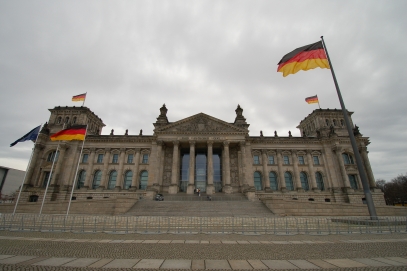
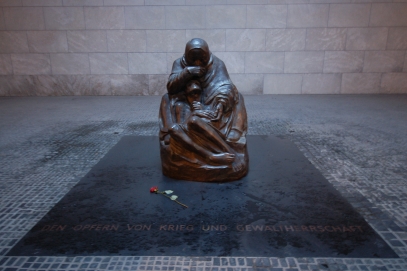
The Reichstag building (1) and the sculpture "Mutter mit Totem Sohn" by German artist Käthe Kollwitz at the New Guard House (2).
New Guard House
The New Guard House was built in 1816 as a guardhouse. In 1931 the government of Prussia transformed the New Guard House into a monument to the German war victims. The reopening of the New Guard House after the Second World War took place in 1960 as a "Memorial to the Victims of Fascism and Militarism". After the unification of Germany in 1993, followed a preliminary final transformation to the "Central Memorial of the Federal Republic of Germany for the Victims of War and Dictatorship".
Ministry of Aviation
The Ministry of Aviation headed by Hermann Göring was founded in April 1933 and had since May 1933 both civil aviation and the air force in its portfolio. Thus arose the need for a new building for the Ministry. Total time of construction of the Ministry with 2,000 offices, several conference rooms and a car park for 240 cars was less than 15 months. The Ministry endured the Second World War virtually unscathed and is still one of the largest buildings in Berlin.
Emperor Wilhelm Memorial Church
The Emperor Wilhelm Memorial Church was built as a Protestant church from 1891 to 1895 by order of Emperor Wilhelm II in memory of his grandfather, Emperor Wilhelm I. On the night of November 23, 1943, the Emperor Wilhelm Memorial Church was heavily damaged in an Allied bombing raid on Berlin. After the Second World War, it was decided to preserve the remainder of the tower and the reception area as a reminder of the war.
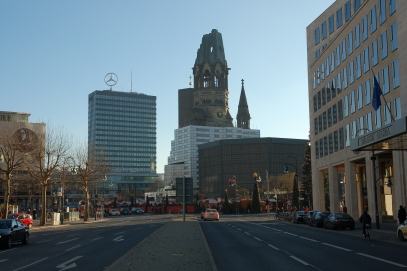
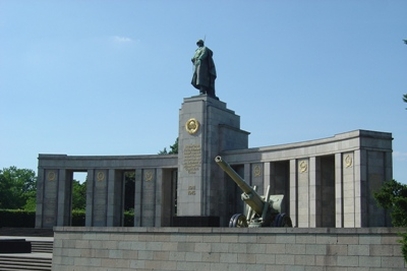
The Emperor Wilhelm Memorial Church (1) surrounded by scaffolding, and the Russian War Memorial (Tiergarten) (2).
Russian War Memorial (Tiergarten)
After the Second World War three official Russian war memorials were established in Berlin. Since the Russian War Memorial (Tiergarten) is located in Berlin's city center, this is the most visited. The Russian war memorials are not only monuments but also war cemeteries. The war memorial is located on the Strasse des 17. Juni at walking distance of the Siegessäule and the Brandenburger Tor. This is the location were the East-West-Axis and the North-South-Axis of World Capital Germania designed by Albert Speer would cross each other.
World Capital Germania
From 1935 to 1943 work was undertaken under the leadership of Adolf Hitler and later Albert Speer on the plans for the new Berlin, later called World Capital Germania. By a decrease in building activities after the outbreak of World War Two, many projects were never realized. On the Strasse des 17. June and Unter den Linden with the Siegessäule and the Brandenburger Tor the idea of the wide East-West-Axis is still visible. Other early examples include the Olympic Stadium and Berlin-Tempelhof Airport.
War Museums in Berlin
Berlin has no major museum with just the Second World War as a subject, but the subject is covered in the German Historical Museum. The Holocaust is the subject of the Jewish Museum Berlin and Topography of Terror. Smaller museums are Otto Weidt’s Workshop for the Blind, the Anne Frank Centre and the Silent Heroes Memorial Centre. For the Russian perspective on the story you can visit the Deutsch Russisches Museum. The technically interested visitor goes to the Deutches Technikmuseum and visitors interested in aviation go to the Luftwaffenmuseum der Bundeswehr.
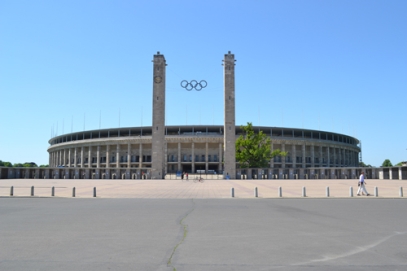
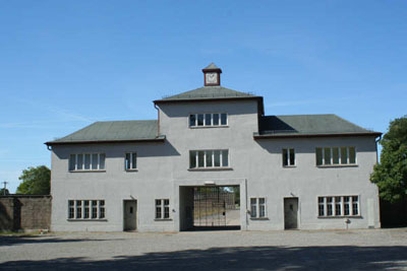
The Olympic Stadium (1) and Concentration Camp Sachsenhausen (2), examples of National Socialist architecture.
Concentration Camp Sachsenhausen
The former Concentration Camp Sachsenhausen is located in Oranienburg at a distance of only 35 kilometers from Berlin. It was the first concentration camp built after Reichsführer-SS Heinrich Himmler was appointed Chief of the German Police. Between the commissioning in 1936 and the liberation by Soviet troops in 1945, more than 200,000 people in total were imprisoned in concentration camp Sachsenhausen. Tens of thousands of prisoners died in the camp or during the death marches.
Source: Barry van Veen


The Field of Stelae of the Holocaust-Memorial (1) and the Brandenburger Tor (2) located at walking distance.
Holocaust-Memorial
The Holocaust-Memorial in Berlin is a monument to the memorial of the murdered European Jews. This memorial is the central German Holocaust Memorial, a place to honour and remember the up to six million Jewish victims of the Holocaust. Located between the Brandenburger Tor and Potsdamer Platz, the Memorial consists of the Field of Stelae designed by Peter Eisenman and a subterranean Information Centre.
Führerbunker
Because he was concerned for his own safety in January 1943 Hitler commissioned Speer to design and then build a shelter bunker, the Führerbunker. In this Führerbunker Hitler spent the last hours of his life. All that remains of the Führerbunker are underground remnants not open to the public. Since many tourists were looking for the location of the Führerbunker it was decided to place an information sign on the location in 2006.
Reichstag building
The Reichstag building is the building of the German Parliament, then the Reichstag and now the Bundestag. The members of the German Parliament met in the Reichstag building until the Reichstag fire of February 27, 1933. During the Battle of Berlin in 1945 the building was one of the major goals of the Red Army. On April 30, 1945 the banner of the Russian 150th Infantry Division was hoisted over the Reichstag building. After the war the Reichstag building was rebuilt and since 1991 it is again the building of the German Parliament.


The Reichstag building (1) and the sculpture "Mutter mit Totem Sohn" by German artist Käthe Kollwitz at the New Guard House (2).
New Guard House
The New Guard House was built in 1816 as a guardhouse. In 1931 the government of Prussia transformed the New Guard House into a monument to the German war victims. The reopening of the New Guard House after the Second World War took place in 1960 as a "Memorial to the Victims of Fascism and Militarism". After the unification of Germany in 1993, followed a preliminary final transformation to the "Central Memorial of the Federal Republic of Germany for the Victims of War and Dictatorship".
Ministry of Aviation
The Ministry of Aviation headed by Hermann Göring was founded in April 1933 and had since May 1933 both civil aviation and the air force in its portfolio. Thus arose the need for a new building for the Ministry. Total time of construction of the Ministry with 2,000 offices, several conference rooms and a car park for 240 cars was less than 15 months. The Ministry endured the Second World War virtually unscathed and is still one of the largest buildings in Berlin.
Emperor Wilhelm Memorial Church
The Emperor Wilhelm Memorial Church was built as a Protestant church from 1891 to 1895 by order of Emperor Wilhelm II in memory of his grandfather, Emperor Wilhelm I. On the night of November 23, 1943, the Emperor Wilhelm Memorial Church was heavily damaged in an Allied bombing raid on Berlin. After the Second World War, it was decided to preserve the remainder of the tower and the reception area as a reminder of the war.


The Emperor Wilhelm Memorial Church (1) surrounded by scaffolding, and the Russian War Memorial (Tiergarten) (2).
Russian War Memorial (Tiergarten)
After the Second World War three official Russian war memorials were established in Berlin. Since the Russian War Memorial (Tiergarten) is located in Berlin's city center, this is the most visited. The Russian war memorials are not only monuments but also war cemeteries. The war memorial is located on the Strasse des 17. Juni at walking distance of the Siegessäule and the Brandenburger Tor. This is the location were the East-West-Axis and the North-South-Axis of World Capital Germania designed by Albert Speer would cross each other.
World Capital Germania
From 1935 to 1943 work was undertaken under the leadership of Adolf Hitler and later Albert Speer on the plans for the new Berlin, later called World Capital Germania. By a decrease in building activities after the outbreak of World War Two, many projects were never realized. On the Strasse des 17. June and Unter den Linden with the Siegessäule and the Brandenburger Tor the idea of the wide East-West-Axis is still visible. Other early examples include the Olympic Stadium and Berlin-Tempelhof Airport.
War Museums in Berlin
Berlin has no major museum with just the Second World War as a subject, but the subject is covered in the German Historical Museum. The Holocaust is the subject of the Jewish Museum Berlin and Topography of Terror. Smaller museums are Otto Weidt’s Workshop for the Blind, the Anne Frank Centre and the Silent Heroes Memorial Centre. For the Russian perspective on the story you can visit the Deutsch Russisches Museum. The technically interested visitor goes to the Deutches Technikmuseum and visitors interested in aviation go to the Luftwaffenmuseum der Bundeswehr.


The Olympic Stadium (1) and Concentration Camp Sachsenhausen (2), examples of National Socialist architecture.
Concentration Camp Sachsenhausen
The former Concentration Camp Sachsenhausen is located in Oranienburg at a distance of only 35 kilometers from Berlin. It was the first concentration camp built after Reichsführer-SS Heinrich Himmler was appointed Chief of the German Police. Between the commissioning in 1936 and the liberation by Soviet troops in 1945, more than 200,000 people in total were imprisoned in concentration camp Sachsenhausen. Tens of thousands of prisoners died in the camp or during the death marches.
Source: Barry van Veen

